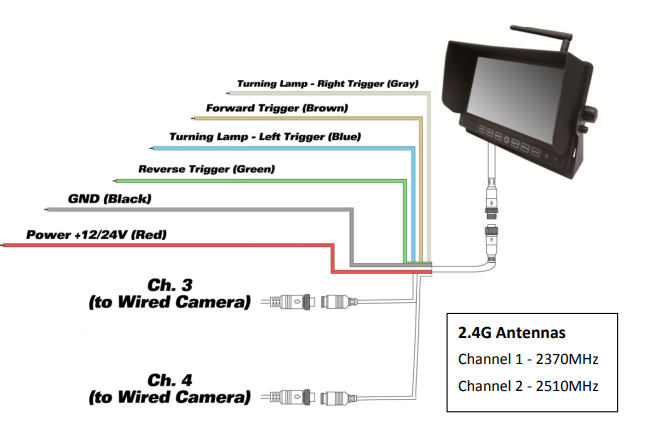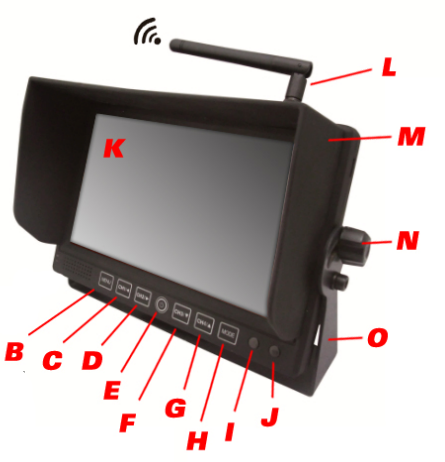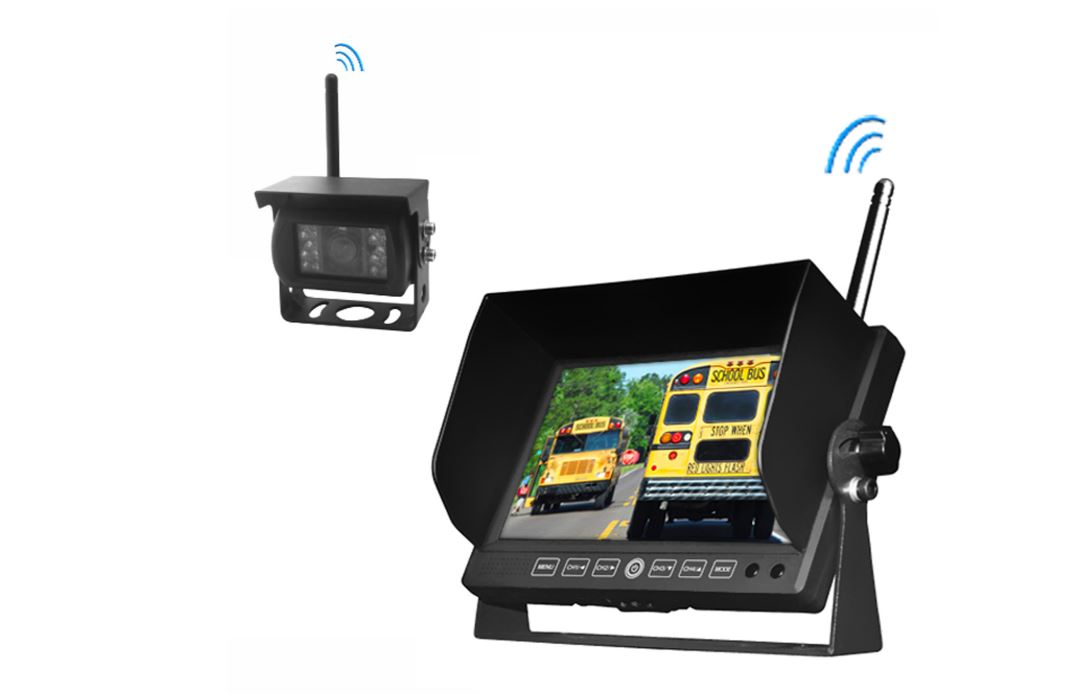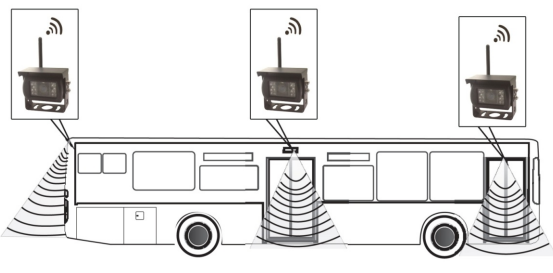
Pyle PLOMTR82WIR Wireless Mobile Video Surveillance System
About Pyle
Pyle is a well-known consumer electronics company specializing in manufacturing a wide range of audio equipment and accessories. The company was founded in 1960 and is based in Brooklyn, New York. Pyle Audio has built a reputation for producing affordable and quality audio products, catering to various consumer needs.
Please read the instructions carefully before installation and use. Installation should be performed by a professional installer.
To ensure your safety, the driver should not watch videos or operate features on the monitor while driving. There are no serviceable parts in this unit, do not disassemble or try to repair this unit. If the unit malfunctions please return it to your vendor or send it to a Pyle repair facility. Please observe and obey the local laws and regulations when installing the unit. Upon Installation, please make sure not to interfere with any of the vehicle’s safety features, wiring, components, etc. We are not responsible for any damages, injury, malfunctions or otherwise noted due to faulty or non‐professional installation.
Connection / Installation
The camera can connect up to 4 cameras (2 wired and 2 wireless ‐ the wired cameras can be connected via the included power and wiring harness, having 2 connector jacks featuring 4‐pin styled connectors. If you desire to take advantage of this optional feature and connect additional cameras, please be sure to use compatible cameras with threaded locking 4‐pin connectors.
- Please visit www.pyleaudio.com to learn more about system compatibility and optional compatible parts.
Camera & Monitor feature built‐in transmitters and receivers, the included antennas need to be connected to the camera and monitor to send & receive the wireless video signals. Wireless signal transmission range up to 300 feet.
- This system includes one camera with a built‐in 2.4G wireless transmitter. The camera can be used as a reverse camera (placed in the rear of your vehicle) or a normal safety driving camera to display the picture as viewed through the lens (when placed on the sides or facing the front of your vehicle). If used as a reverse camera, be sure to wire the ‘Reverse Trigger (Green)’ cable accordingly.
Users will also have the ability to flip the camera picture as displayed on the LCD screen display. The button controls on the monitor panel allow the picture to be flipped horizontally (Left / Right) for backup rearview camera viewing. Not flipping the picture will out the camera picture to the monitor displays the camera picture as seen through the camera lens. This type of display output is used for any camera facing the front of your vehicle.
Versatile Mounting Installation
Wiring & Connection
Optional Wireless Camera Connection:
Use the wiring chart above to connect your camera system accordingly. If multiple cameras are used the colored trigger wires serve as automatic camera and display activation connections.
- Channels 1 & 2 are reserved for wireless camera connection. Channels 3 & 4 are reserved for wired cameras, as the included power and power harness has 2 additional input connectors for compatible 4‐pin cameras. These options are available for users who wish to connect additional cameras to the system.
Note
Please note, that system installation includes optional methods of camera setup as users can choose to incorporate additional camera sources to the camera and video system.

Note
Please note, that in cold weather and temperatures, the display monitor may require some time to ‘warm up’ to display a picture on the screen.
Monitor Stand Mounting
- The U‐shaped mount stand bracket separates from the LCD housing for attachment/fixture. The U‐shaped bracket attaches to the desired location via 3 screw holes located at the base of the bracket. Please remove the LCD monitor from the bracket before attempting to secure the bracket to your desired location.
- Once screwed into the desired location, attach the LCD monitor housing and tighten it with the tightening knob to the side of the housing. Adjust the angle/tilt of the LCD before tightening the side knob.
Model: PLCMTR82WIR
- Wireless Weatherproof Rearview Backup Camera & Monitor Video System, Commercial Grade, Night Vision Camera, 7” Display, Dual DC 12‐24V for Bus, Truck, Trailer, Van
- Camera & Monitor Vehicle Safety Video System Wireless 2.4G Signal Transmitter & Receiver
- Wireless Range: Over 300′ Feet Designed for Car/Truck use 12/24 Volt Systems
- Includes All Necessary Cables & Wiring
System Includes
- Monitor with Built‐in Receiver
- Camera with Built‐in Transmitter
- Power & Wiring Harness
- Camera DC Power Cable
- (2) 2.4G Wireless Antennas
Camera
- Weatherproof Rearview Camera System
- Wireless Transmitter Built‐into Camera
- Weatherproof Marine Grade Construction
- IP68 Rating Water & Fog Resistance
- LED Lights with IR Night Vision Illumination
- Low Lux Light Performance
- Image Sensor: SHARP Color 1/4” CMD
- System: PAL/NTSC Auto Switching
- Video Output 1.0V pp‐75 Ohm
- Lens Angle: 170 Degree
- Min. Illumination: 0.2 Lux
- Auto Image Adjustment
- Camera Dimensions (W x H x D): 3.18″ x 2.95″ x 2.17
FAQS About Pyle PLOMTR82WIR Wireless Mobile Video Surveillance System
How are power sources for wireless security cameras?
The power is provided by onboard batteries, typically using lithium-ion cells. In actuality, though, cables are used to connect the great majority. The majority of wireless cameras are not, in fact, wireless.
What is the duration of its power?
Lithium-ion batteries are unique in that they deliver remarkably reliable power but gradually degrade over time. A lithium-ion cell left on a shelf will progressively lose power even when not in use. At most, wireless security camera batteries have a lifespan of one to three years. They are far simpler to replace than a watch battery. Like taking off and re-buttoning your shirt! However, a power cord is typically used to power wireless security cameras.
How does data get sent between wireless security cameras?
through 2.4GHz and 5.8GHz broadcasts. Data is transmitted by transmitters via wireless signals, which receivers subsequently receive.
What is the wireless camera’s range?
Using 2.4 GHz, up to 2000 feet, and 5.8 GHz, up to 600–700 feet. Due to walls and other obstacles, the space is much more constrained within a house.
Is it possible to increase a wireless security system’s range?
Absolutely. A wireless signal can be amplified down a line of repeaters by utilizing repeaters. But the more repeaters you utilize, the worse the video quality is likely to be. Of course, a greater distance also leaves more room for obstructions to the signal.
Does frame rate depend on signal strength?
Yes! Therefore, it’s crucial to have a signal that is as strong as feasible. Even with the best and most powerful camera, if the data cannot be transmitted clearly, the video playback will be choppy and sluggish. This is also the reason why you can use repeaters to increase a wireless camera’s range, but you have to realize that doing so will degrade the overall quality of the video.
Can conflicting signals slow down an internet connection?
Yup! Because of this, you must be careful where you put your wireless security cameras. Additionally, you should be aware of the signal frequencies they use, which are commonly 2.4 GHz or 5.8 GHz, and keep those from competing for signal strength.
Could someone ‘hack’ into my wifi security camera?
Yes. Don’t go right away, please. If you leave your wireless security system’s security at the default settings, it is very possible for someone to hack into it. Of course, you shouldn’t leave it on those settings. It is strongly advised that you change the ports it uses, preferably to an uncommon port. Additionally, we advise updating the password and address name for the camera. Instead of being visible, the security system ought to be hidden behind your internet.
Where is the video stored?
There are two options: either on the camera directly using an internal SD Memory Card, or via an associated network video recorder. For every security system, including one with wireless cameras, we strongly advise purchasing a network video recorder. Although useful, SD Memory Cards require physical retrieval in order to access the data on them. And even while these little devices now have a lot of storage space, nothing compares to a real hard drive that can store weeks’ worth of video content!
If I have space for wired cameras, is there any need to go wireless?
No. Unusual given that the article’s focus seemed to be on wireless cameras, but in general, wired security cameras are more dependable and frequently less expensive. If you really must go wireless, we advise against it. They are very reliable goods, especially when compared to earlier models, although wired has always been of higher, more consistent quality.
For more manuals by Pyle, Visit Manualsdock



